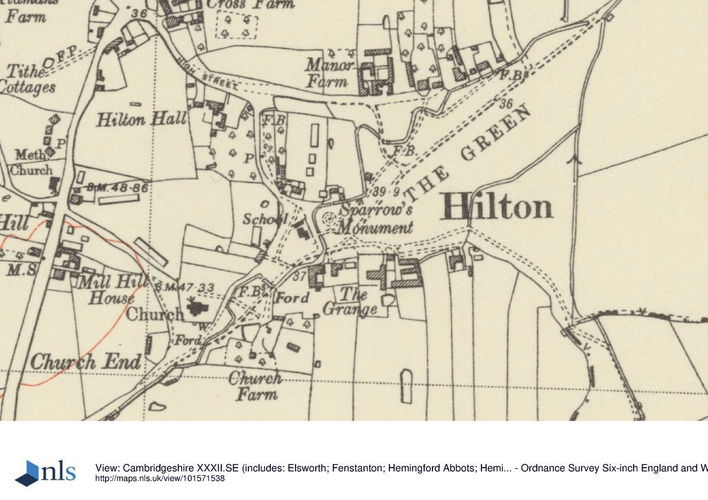

Introduction
Hilton Maze is a turf maze 14 metres in diameter, which is believed to have been first cut in 1660, and has been re-cut several times since. A central stone pier is inscribed in memory of William Sparrow, creator of the maze, who died in 1729.
The Maze is 53 feet in diameter. In the centre is a stone pier with cornice and ball sundial. It was created by William Sparrow, to whom there is an inscription on the pier: ‘Ad hoc William Sparrow departed this life on the 25th of August anno Domini 1729, aged 88 years’. The central rings of the maze were obscured to make way for the memorial and in 1800 was recut incorrectly. In 1967 it was again recut, correctly, by P.G.M. Dickinson, the Huntingdon historian, restoring the original network of passages.
The following is from the Register of Parks and Gardens of Special Historic Interest. For the most up-to-date Register entry, please visit the The National Heritage List for England (NHLE):
www.historicengland.org.uk/listing/the-list
A turf maze on the village green, first cut, or possibly re-cut, in 1660 and re-cut several times since.
DESCRIPTION
LOCATION, AREA, BOUNDARIES, LANDFORM, SETTING
The village of Hilton lies c 12km west-north-west of Cambridge, c 3km to the south of the main A14 Cambridge to Huntingdon road. The village green is situated on the eastern edge of the village, with the maze at its south-west corner, beside the junction of Maze Road and The Grove and bordered to the north by a small stream.
The Green covers c 15ha in all with the maze (scheduled ancient monument) occupying an area c 16.7m in diameter within a low sunken wall. The maze is created by raised turfs, laid in a circular, traditional 'Chatres' pattern, with the inner two circles removed during the re-cutting in 1967. At the centre is a square stone obelisk, Sparrow's Monument (listed grade II), erected in 1729 to mark the death of William Sparrow who cut the maze in 1660 at the age of nineteen. The obelisk is inscribed in Latin: sic transit gloria mundi. Gulielmus Sparrow, Gen, natus ano. 1641. Aestatis sui 88 quandro oblit hos gyros formavit anno 1660, which translates to: 'here passes the glory of the world, William Sparrow, born in the year 1641, died aged 88, formed these rings in the year 1660'. On top of the obelisk is a ball ornamented with a sundial. Writing in 1774, J Hutchins records that the Hilton maze was not composed of turf banks but was laid out using paths of pebbles (Pennick 1990) and almost 100 years later, in 1854, a local history continues to record the existence of pebbles rather than turf. During the latter part of the C19 however the pebbles became covered with turf and the area was grazed by cattle. In 1899 the maze was restored by cutting turf paths, but not to the original pattern. In 1967 Philip Dickinson again re-cut the maze and uncovered some of the original pebbles. During the past ten years the outer boundary wall has been strengthened with concrete.
REFERENCES
W H Matthews, Mazes and Labyrinths (1922), pp 85-6
N Pevsner, The Buildings of England: Bedfordshire and the county of Huntingdon and Peterborough (1968), p 263
R Halliday, Three Cambridgeshire Mazes (1989), pp 44-7
N Pennick, Mazes and Labyrinths (1990), pp 68-72
J Dady, Hilton, Huntingdonshire (1992), pp 60-1 Hilton Village Handbook (1999)
Maps
OS 25" to 1 mile:
1st edition published 1887
3rd edition published 1924
Description written: October 1999 Amended: December 2000
Register Inspector: EMP
Edited: January 2001
- Visitor Access, Directions & Contacts
Access contact details
On Hilton village common
Directions
On Hilton village common
- History
One of three turf mazes remaining in England, the Hilton Maze on the village green, north east of the village church, was cut in 1660.
The following is from the Register of Parks and Gardens of Special Historic Interest. For the most up-to-date Register entry, please visit the The National Heritage List for England (NHLE):
www.historicengland.org.uk/listing/the-list
HISTORIC DEVELOPMENT
Hilton Maze stands on common land at the southern end of Hilton Green, the obelisk which stands at its centre recording that it was cut by William Sparrow in the year 1660. Sparrow lived at Park Farm which looked out onto the Green and the site of the maze and he cut the pattern to commemorate the year of the Restoration of King Charles II. It has been suggested that in fact Sparrow re-cut an earlier maze which had fallen into disuse during Cromwell's suppression (Pennick 1990). Lancelot Brown (1716-1783) purchased the manor of Fenstanton and Hilton in 1767 and a map by John Spyers, commissioned by Brown in 1778, records a well-laid-out village green at Hilton which local tradition believes to have been designed by Brown himself. The plan of the maze has changed several times in the last 140 years, the most recent plan having been executed by local historian Philip Dickinson in 1967. The management of the site remains (1999) the responsibility of the Parish Council.
- Features & Designations
Designations
The National Heritage List for England: Register of Parks and Gardens
- Reference: GD1614
- Grade: II
Features
- Turf Maze
- Key Information
Type
Maze
Purpose
Ornamental
Principal Building
Commemorative
Survival
Extant
Hectares
0.1
Open to the public
Yes
Civil Parish
Hilton
- References
References
- {English Heritage Register of Parks and Gardens of Special Historic Interest} (Swindon: English Heritage 2008) [on CD-Rom] Historic England Register of Parks and Gardens of Special Historic Interest
- Pevsner, N {The Buildings of England: Bedfordshire and the County of Huntingdon and Peterborough} (Harmondsworth: Penguin, 1968) p 263 The Buildings of England: Bedfordshire and the county of Huntingdon and Peterborough
Contributors
Cambridgeshire Gardens Trust